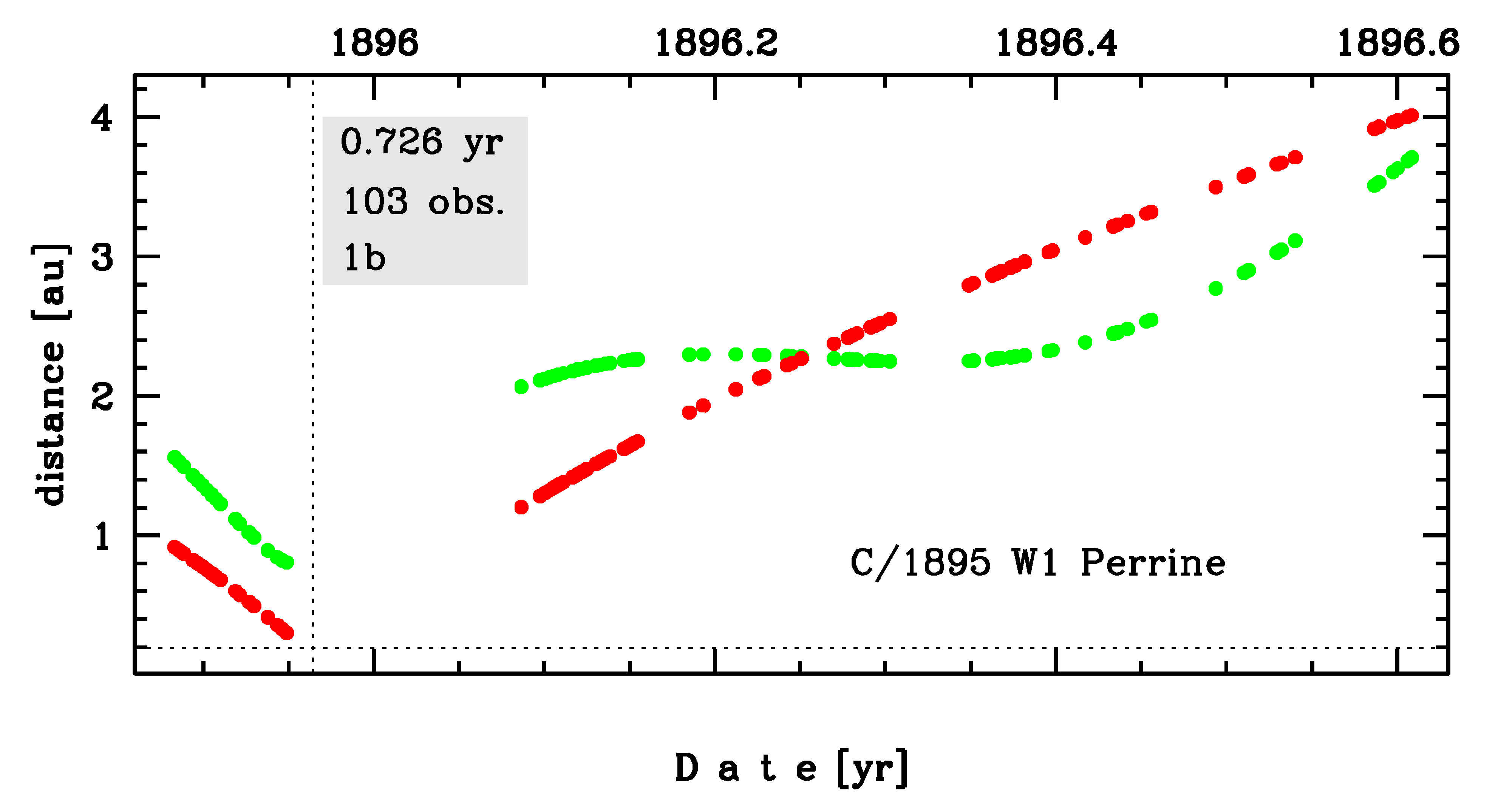C/1895 W1 Perrine
more info
C/1895 W1 was discovered on 17 November 1895 by Charles Dillon Perrine (Lick Observatory, California, USA), that is about a month before its perihelion passage, and it was last seen on 10 August 1896 [Kronk, Cometography: Volume 2].
This comet made its closest approach to the Earth on 14 December 1895 (0.794 au), that is 4 days before perihelion passage.
Solutions given here are based on data spanning over 0.726 yr in a range of heliocentric distances from 0.92 au through perihelion (0.192 au) to 4.01 au.
This comet suffers small planetary perturbations during its passage through the planetary system; these perturbations lead to a more tight future orbit with a semimajor axis of about 2,300 au (see future barycentric orbits).
See also Królikowska 2020.
This comet made its closest approach to the Earth on 14 December 1895 (0.794 au), that is 4 days before perihelion passage.
Solutions given here are based on data spanning over 0.726 yr in a range of heliocentric distances from 0.92 au through perihelion (0.192 au) to 4.01 au.
This comet suffers small planetary perturbations during its passage through the planetary system; these perturbations lead to a more tight future orbit with a semimajor axis of about 2,300 au (see future barycentric orbits).
See also Królikowska 2020.
| solution description | ||
|---|---|---|
| number of observations | 103 | |
| data interval | 1895 11 18 – 1896 08 10 | |
| data type | perihelion within the observation arc (FULL) | |
| data arc selection | entire data set (STD) | |
| range of heliocentric distances | 0.92 au – 0.19 au (perihelion) – 4.01 au | |
| type of model of motion | NS - non-gravitational orbits for standard g(r) | |
| data weighting | YES | |
| number of residuals | 156 | |
| RMS [arcseconds] | 2.42 | |
| orbit quality class | 2a | |
| next orbit statistics, both Galactic and stellar perturbations were taken into account | ||
|---|---|---|
| no. of returning VCs in the swarm | 5001 | * |
| no. of escaping VCs in the swarm | 0 | |
| no. of hyperbolas among escaping VCs in the swarm | 0 | |
| next reciprocal semi-major axis [10-6 au-1] | 395.61 – 427.10 – 459.57 | |
| next perihelion distance [au] | 0.19374 – 0.19383 – 0.19387 | |
| next aphelion distance [103 au] | 4.35 – 4.68 – 5.06 | |
| time interval to next perihelion [Myr] | 0.1 – 0.11 – 0.13 | |
| percentage of VCs with qnext < 10 | 100 | |
| next_g orbit statistics, here only the Galactic tide has been included | ||
|---|---|---|
| no. of returning VCs in the swarm | 5001 | * |
| no. of escaping VCs in the swarm | 0 | |
| no. of hyperbolas among escaping VCs in the swarm | 0 | |
| next reciprocal semi-major axis [10-6 au-1] | 395.62 – 427.10 – 459.57 | |
| next perihelion distance [au] | 0.19273 – 0.19287 – 0.19297 | |
| next aphelion distance [103 au] | 4.35 – 4.68 – 5.06 | |
| time interval to next perihelion [Myr] | 0.1 – 0.11 – 0.13 | |
| percentage of VCs with qnext < 10 | 100 | |
